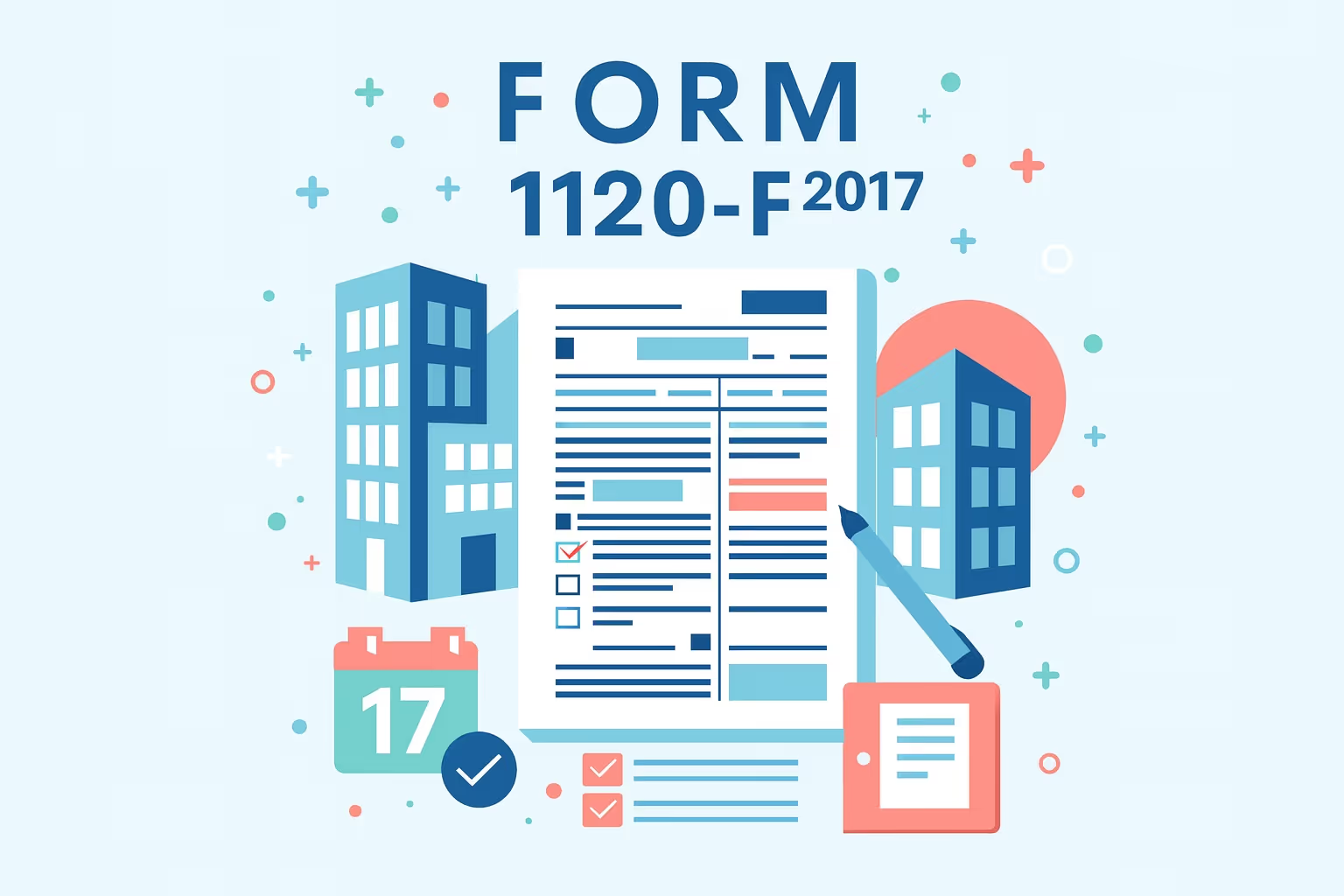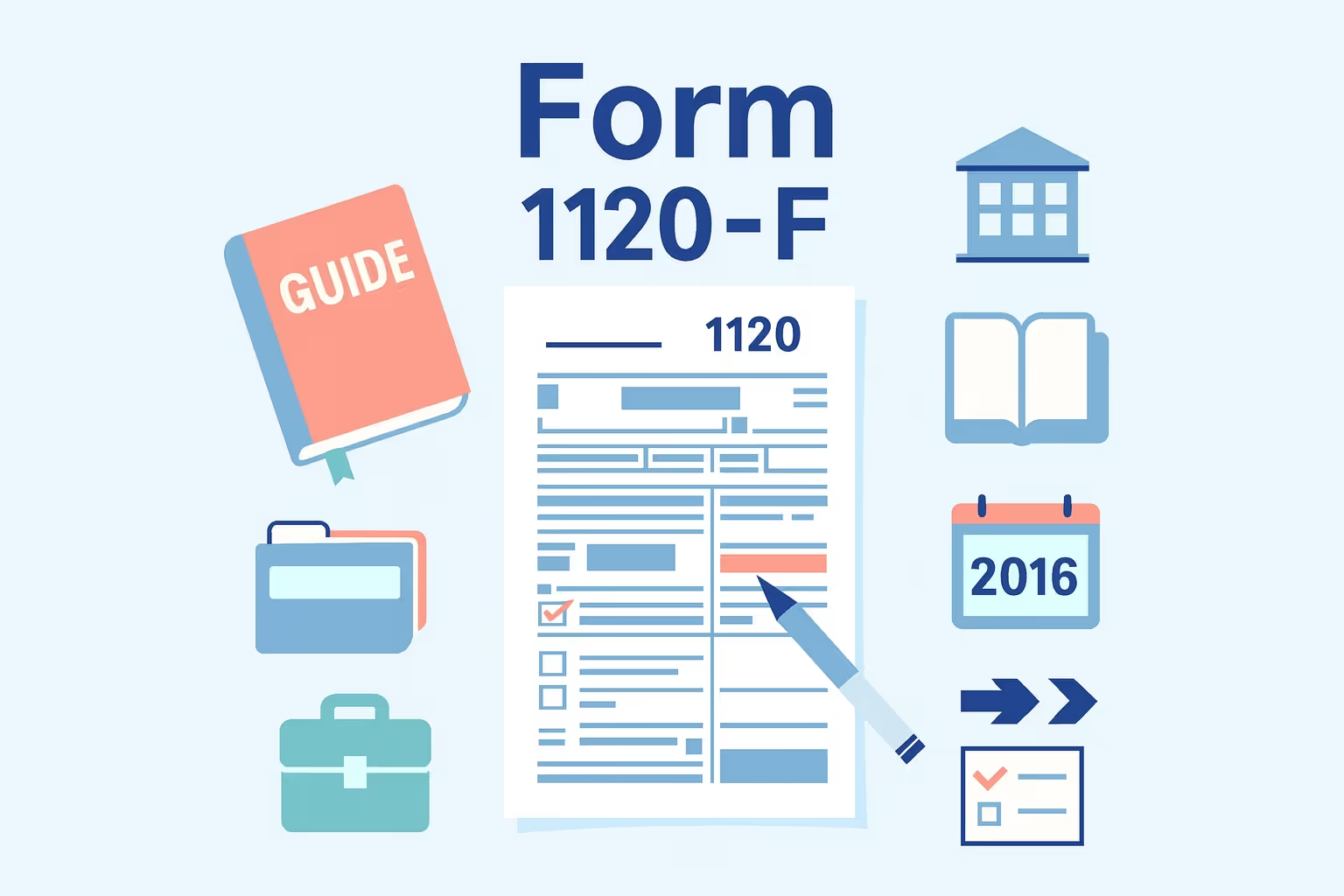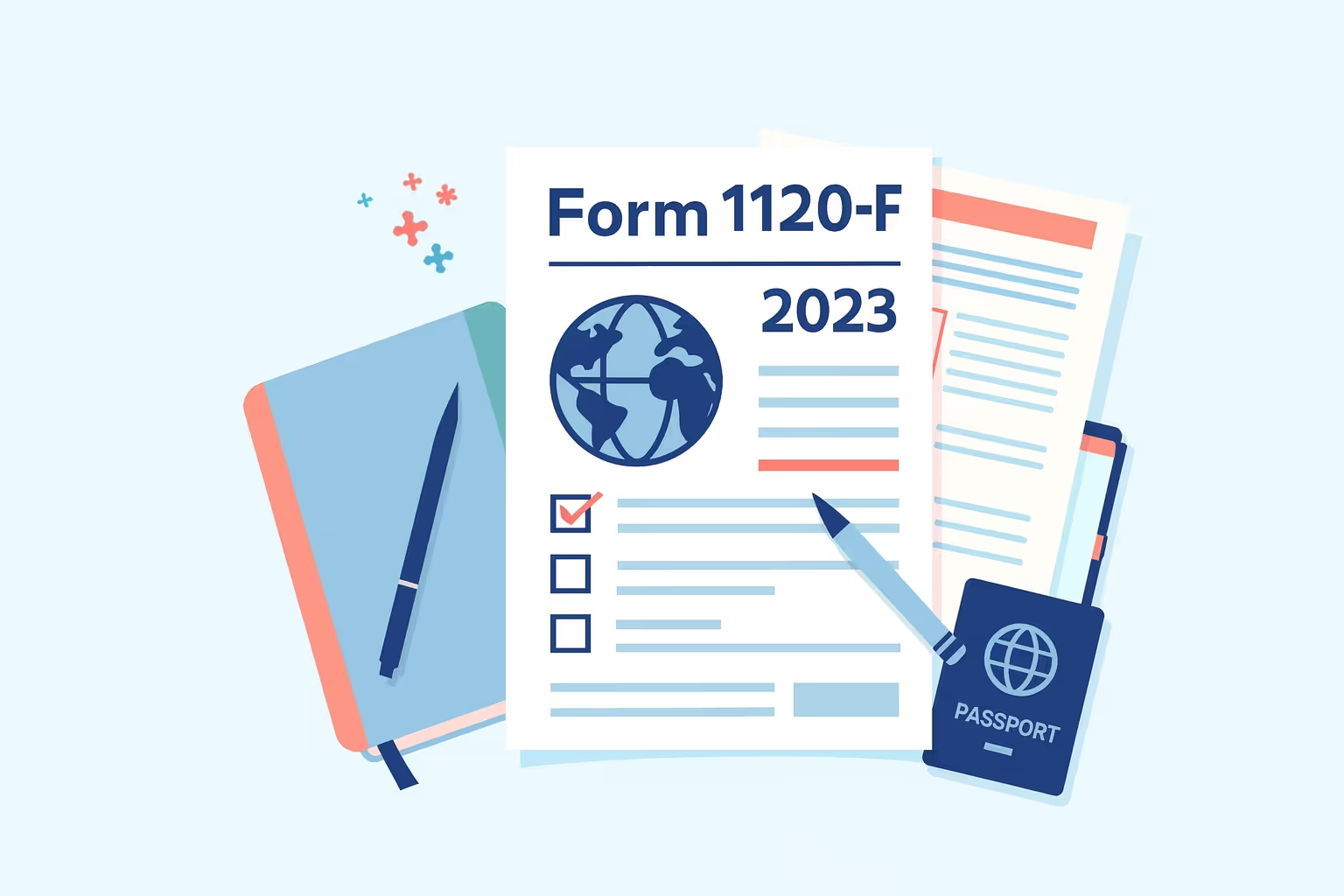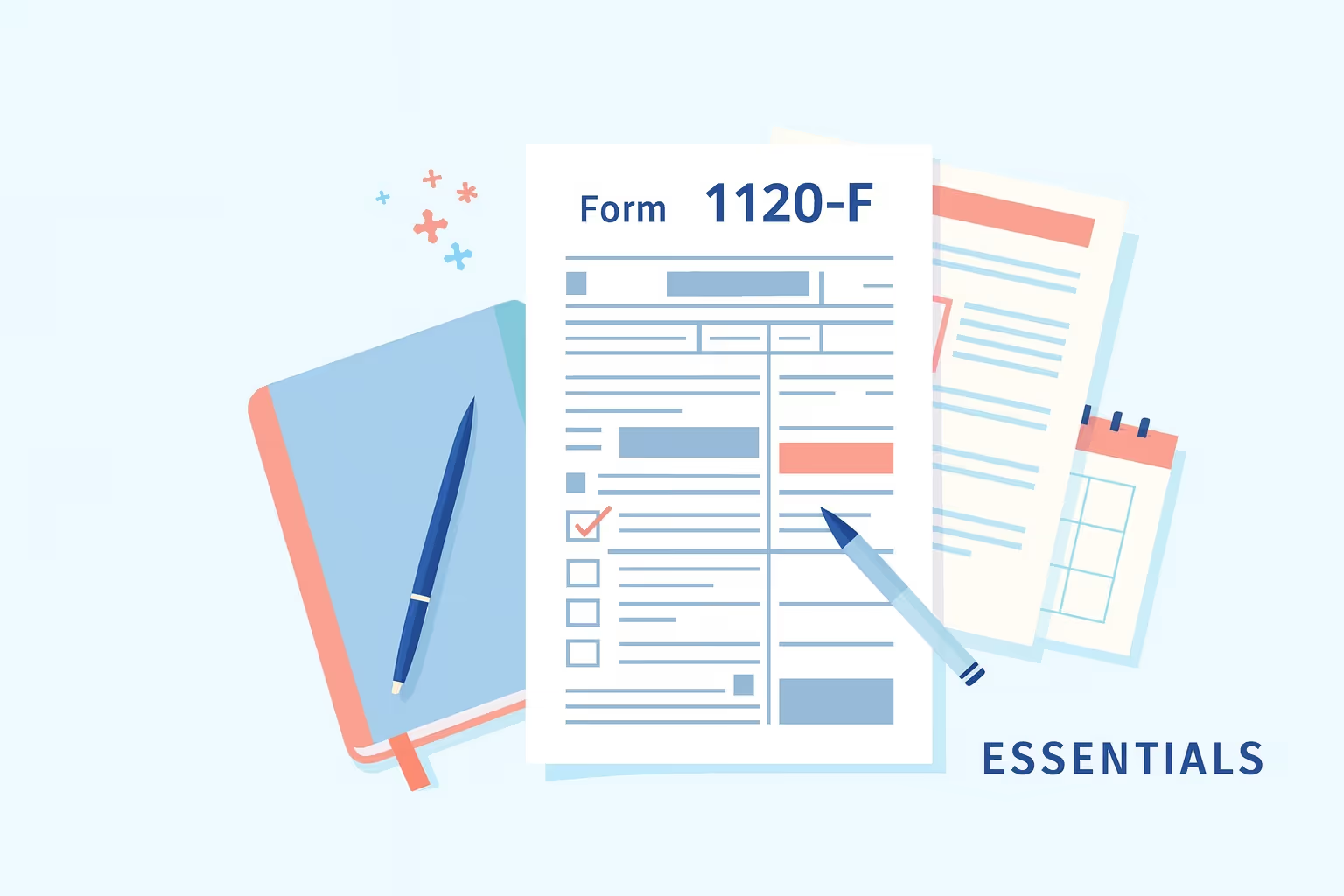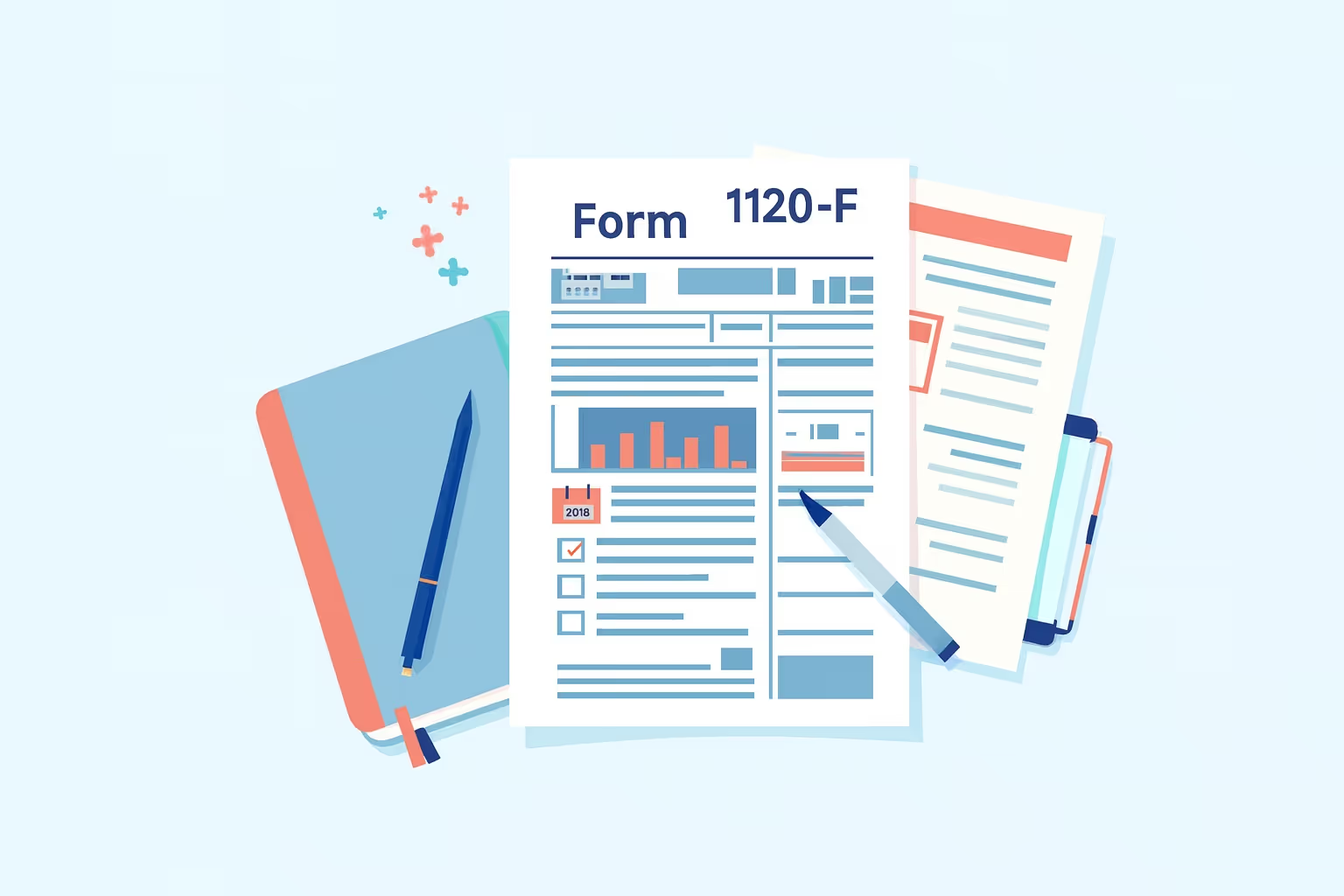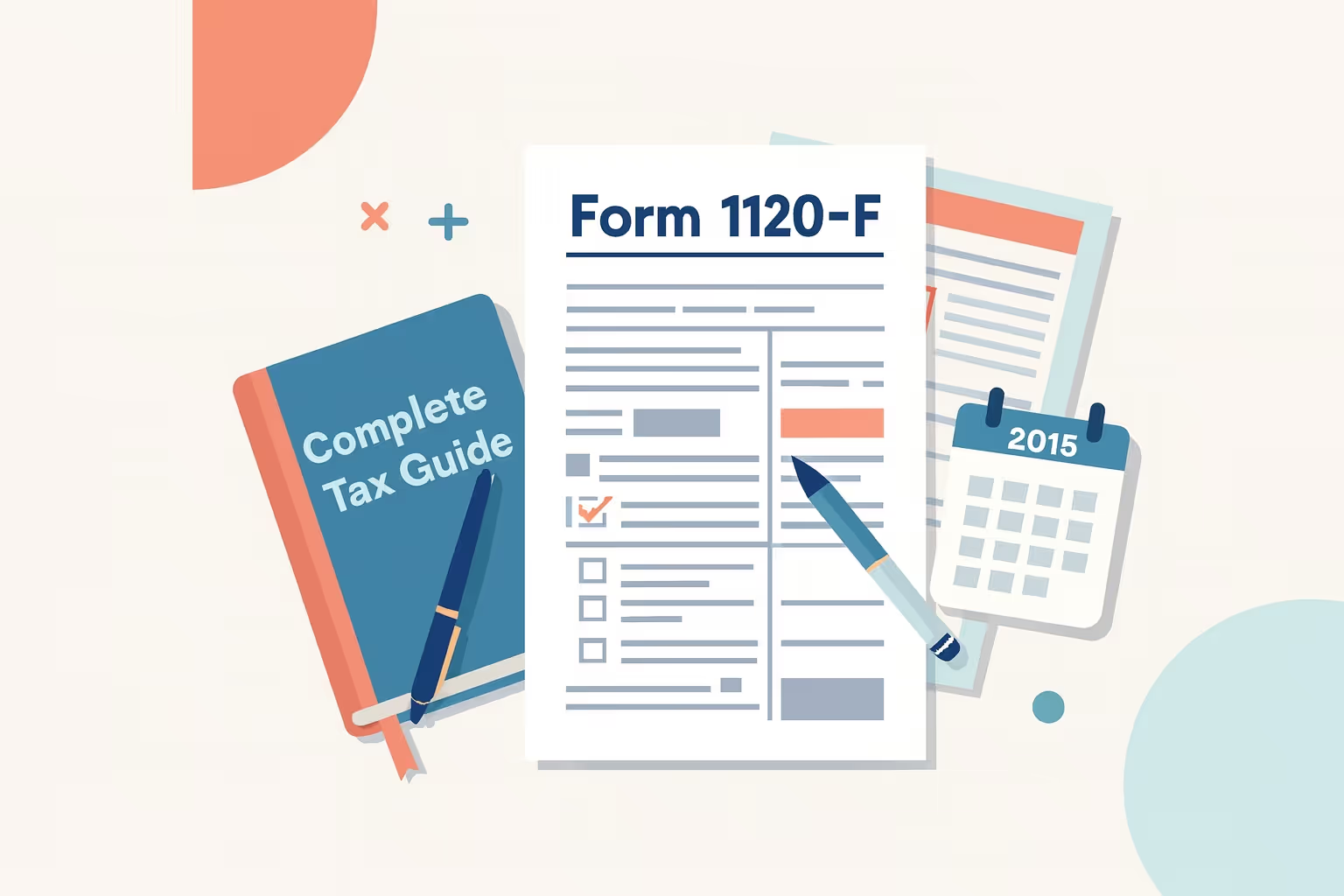Essential Guide to Form 1120-F 2022 Instructions
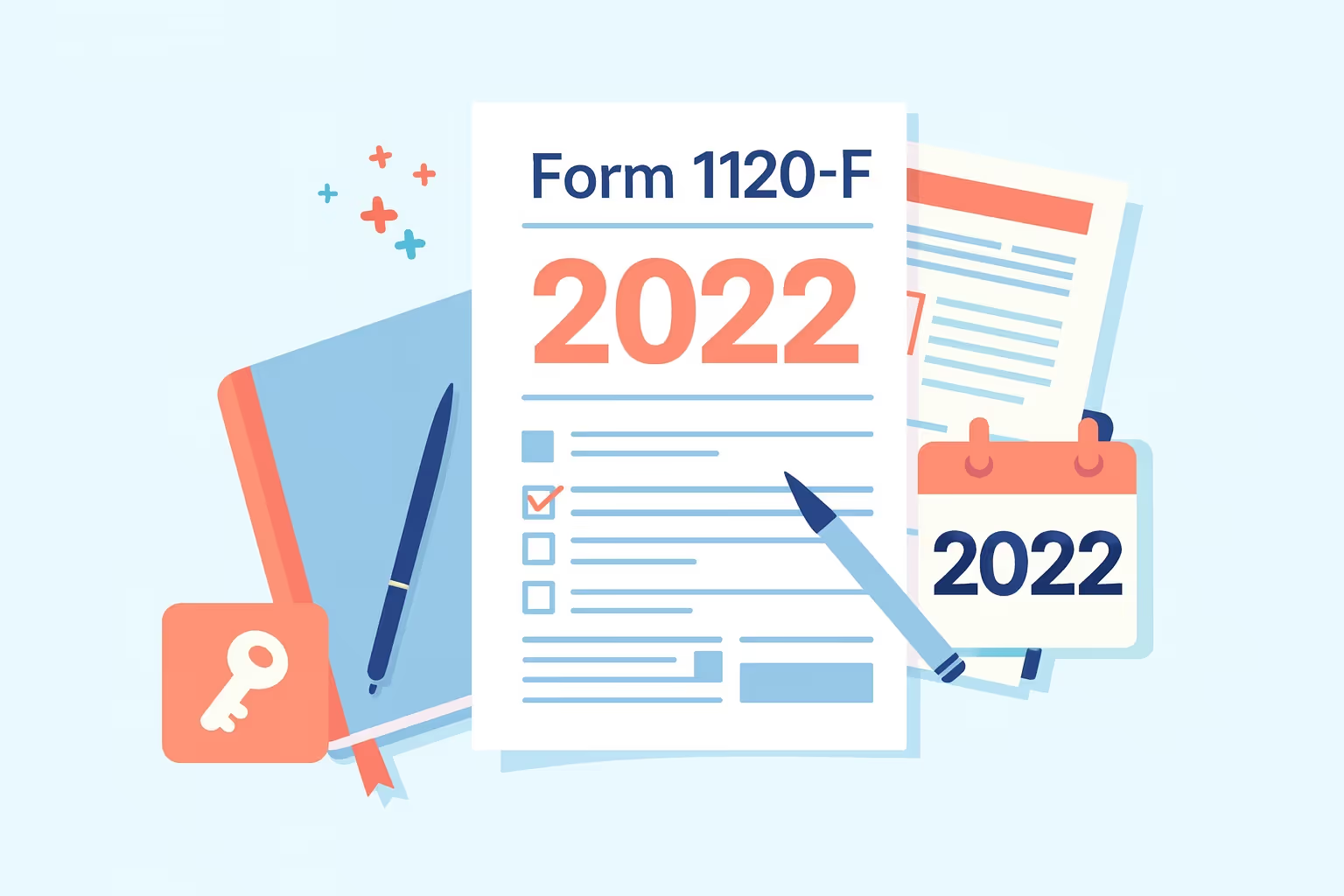
Form 1120-F is the U.S. Income Tax Return of a Foreign Corporation. It’s used by foreign businesses that earn income from U.S. trade or business activities. Using the latest IRS instructions, this essential guide explains how to complete Form 1120-F for the 2022 tax year. It’s designed to help foreign corporations accurately report income, deductions, and taxes while meeting all filing and disclosure requirements.
Filing correctly is crucial because Form 1120-F determines a foreign corporation’s tax liability for effectively connected income (ECI) and other U.S. source income. Errors or late submissions can result in penalties, disallowed deductions, or loss of treaty benefits. The 2022 instructions include updates on filing penalties, new Schedule P sections, and adjustments related to the corporate alternative minimum tax (AMT).
This guide walks you through the process—from identifying who must file to attaching required schedules and understanding key terms like ECI, FDAP income, and branch profits tax. Whether you’re filing for the first time or updating previous returns, these steps will help ensure full compliance with IRS Form 1120-F 2022 instructions and prevent common mistakes that delay processing or increase tax exposure.
What Is Form 1120-F?
Form 1120-F, officially called the U.S. Income Tax Return of a Foreign Corporation, is the federal tax form used by non-U.S. companies that earn income from U.S. sources or conduct business within the United States. The IRS requires this form to calculate and report a corporation’s tax liability in the U.S. for effectively connected income (ECI) and fixed, determinable, annual, or periodical (FDAP) income.
1. Purpose of the Form
- Form 1120-F ensures foreign corporations pay the correct U.S. income tax on profits connected to their American operations.
- It allows corporations to claim deductions, apply tax treaty benefits, and reconcile withholding taxes already paid on U.S.-source income.
2. Key Terms to Understand
- Effectively Connected Income (ECI): Business income tied to a trade or business in the U.S. It is taxed at standard corporate rates, and deductions are allowed.
- FDAP Income: Passive income such as dividends, rents, royalties, or interest. Unless a tax treaty reduces that rate, it is subject to a 30% withholding tax.
3. Typical Filers
Foreign entities required to file Form 1120-F generally include:
- Foreign corporations engaged in U.S. trade or business activities must file Form 1120-F to report income effectively connected to their operations in the United States.
- Companies seeking refunds for overwithheld taxes must file Form 1120-F to recover amounts withheld beyond their actual U.S. tax liability.
- Corporations claiming treaty-based exemptions must file Form 1120-F to disclose the specific tax treaty positions that reduce or eliminate their U.S. tax obligations.
Failure to file may result in penalties or the loss of valuable deductions and credits. For detailed filing guidance, visit the IRS page for Form 1120-F.
Who Must File Form 1120-F for 2022?
A foreign corporation must file Form 1120-F for tax year 2022 if any of the following conditions apply:
- It was engaged in a trade or business within the United States, regardless of whether it earned income from U.S. sources or whether that income was exempt under a tax treaty.
- It had income, gains, or losses that were treated as effectively connected with a U.S. trade or business (known as effectively connected income, or ECI).
- Although it did not conduct a U.S. trade or business, it received income from U.S. sources, and its tax liability for that income was not fully satisfied by withholding.
- It had a branch that was a qualified derivatives dealer (QDD).
In addition:
- A foreign corporation claiming a refund of U.S. tax withheld at source must file.
- A corporation claiming deductions, credits, or treaty-based exemptions must file to support those positions.
- Even if a corporation has no gross income because it is claiming a treaty or Code exemption, it still must file to reflect the exclusion (only basic identifying information is required in that case).
Foreign entities that fail to file lose the right to claim deductions or credits against ECI and may incur penalties. For full details, see the official IRS 2022 Form 1120-F instructions.
Key Updates and Changes for Tax Year 2022
The IRS introduced several essential updates to Form 1120-F for tax year 2022. These changes affect filing penalties, schedule reporting, and corporate tax calculations. Understanding each update helps foreign corporations maintain compliance and avoid errors when completing their return.
Increased Late Filing Penalty
- The minimum penalty for filing a return more than 60 days after the due date increased to $450, up from $435.
- The penalty applies to any late-filed return, even if no tax is due, and is limited to the smaller $450 or the total tax owed.
Schedule P Revisions
- Two new parts—Part IV and Part V—have been added.
- These sections require reporting of foreign partner transfers of partnership interests and gain or loss calculations related to those transfers.
Alternative Minimum Tax (AMT)
- The Inflation Reduction Act of 2022 introduced a new corporate AMT for applicable corporations.
- The change applies to tax years beginning after December 31, 2022, and may impact foreign corporations with significant book income.
Advanced Manufacturing Investment Credit
Corporations investing in qualifying advanced manufacturing facilities can now elect to treat the credit as a deemed payment, simplifying credit utilization.
Expired COVID-Related Payroll Credits
The credit for qualified leave wages paid under COVID provisions now applies only to wages earned before October 1, 2021.
These updates ensure that Form 1120-F reflects current tax law changes and accurate reporting standards for foreign corporations filing 2022 returns.
Step-by-Step Instructions for Completing Form 1120-F
Completing Form 1120-F requires accuracy, organization, and an understanding of U.S. tax rules for foreign entities. The following steps outline how to correctly prepare and file this form for tax purposes, ensuring compliance with U.S. tax law and minimizing the risk of penalties.
Step 1 – Gather Required Information
Before preparing your U.S. tax return, collect the documents and details needed to complete the form accurately. You’ll need:
- The corporation’s Employer Identification Number (EIN), country of incorporation, and complete U.S. business address.
- Financial statements showing gross receipts, deductions, and any foreign source income.
- The supporting forms, such as Forms 1042-S, W-8BEN-E, and partnership agreements, are related to specific U.S. operations transactions.
- Documentation for treaty-based exemptions or certain exceptions under IRS rules.
Having all information ready helps ensure that your filing reflects the correct taxable income and qualifies for allowable deductions.
Step 2 – Complete the Form Header
At the top of Form 1120-F, enter your corporation’s name, EIN, and filing type—initial, final, amended, or protective return. Be sure to mark the correct tax year and confirm the original due date for timely filing. Accuracy here is critical since mismatched information can delay processing or cause non-compliance notices from the IRS.
Step 3 – Fill Out Income Sections
Form 1120-F separates U.S. and foreign income into two parts:
- Section I – Non-Effectively Connected Income (FDAP): Report passive U.S. income such as interest, rents, royalties, or dividends. This income is usually subject to withholding but not eligible for deductions.
- Section II – Effectively Connected Income (ECI): Report business income from U.S. operations. This includes sales, services, or property income linked to U.S. trade or business activities. Deductions for a foreign corporation’s deductible expenses—such as salaries, rent, depreciation, and interest—must be itemized to calculate net taxable income.
Step 4 – Calculate Tax and Branch Profits Tax
After entering income and deductions, calculate your corporation’s income tax liability. Include the regular corporate tax and, if applicable, the branch profits tax on your U.S. earnings. The branch profits tax applies when profits are repatriated from U.S. operations to the foreign parent. Use the relevant regulations sections and applicable tax treaty provisions to determine any reduced rate or exemption.
Step 5 – Attach Required Schedules and Forms
Attach all relevant schedules to support your income and deduction calculations. Common attachments include:
- Schedule H for deductions allocated to ECI.
- Schedule I for interest expense allocation.
- Schedules M-1 and M-3 are used to reconcile the book and tax income.
- Form 8833 to disclose treaty-based positions.
These forms ensure full disclosure of international tax obligations and help the IRS verify compliance.
Step 6 – Sign, File, and Retain Records
Once complete, the return must be signed by an authorized officer. Keep all supporting records—income statements, contracts, and expense documentation—for at least three years. Retaining these documents helps substantiate your U.S. tax return if reviewed by the IRS.
Failure to file by the original due date or to meet disclosure requirements may result in non-compliance penalties and potential loss of deductions or credits. Filing accurately and on time safeguards your foreign corporation’s standing under U.S. tax law and demonstrates a commitment to proper reporting of international operations.
Filing Methods and Deadlines
Foreign corporations must file Form 1120-F according to U.S. tax law to remain compliant and avoid penalties. The appropriate filing method—electronic or paper—depends on the corporation’s structure, income type, and reporting categories. Understanding these options and meeting the deadline are essential for accurately filing your U.S. tax return.
Electronic Filing (E-file)
E-filing is preferred for most corporations because it is secure, efficient, and minimizes errors.
- Who must e-file: Corporations with total assets of $10 million or more and that file 250 or more returns annually must submit Form 1120-F electronically.
- Advantages:
- E-filing reduces the risk of entering the wrong figure or omitting important information, ensuring accuracy throughout the return.
- It gives corporations instant confirmation that the IRS has received their filing.
- It ensures full compliance with IRS data validation standards, minimizing the likelihood of processing delays or rejection.
- Example: A foreign corporation with a U.S. branch that earns effectively connected income and non-ECI (passive income such as interest or dividends) must e-file to comply with federal requirements.
Paper Filing
Some corporations may still qualify for paper submission.
- Mailing address:
Internal Revenue Service
P.O. Box 409101
Ogden, UT 84409 - Filing instructions:
- Attach all required schedules and documentation for transactions involving related parties or cross-border activities.
- Verify every number, especially inventory and income balances, to ensure accuracy.
- Remember that missing pages or mismatched data can cause delays or rejection.
- Attach all required schedules and documentation for transactions involving related parties or cross-border activities.
Deadlines and Extensions
Meeting IRS deadlines is crucial for compliance and avoiding penalties.
- With a U.S. office: File by the 15th day of the fourth month after the tax year ends.
- Without a U.S. office: File by the 15th day of the sixth month after the tax year ends.
- Extension: Submit Form 7004 for an automatic six-month extension, but remember that it only extends the time to file—not to pay.
Importance of Timeliness:
Filing before the original due date demonstrates responsibility and accuracy. Corporations that miss deadlines risk financial penalties, interest, and possible non-compliance status. Paying close attention to due dates, verifying figures, and maintaining accurate records ensures compliance with U.S. tax law and supports transparency for specific types of international filers.
Payment and Penalty Rules
Foreign corporations filing Form 1120-F must follow the payment and penalty procedures established under U.S. tax law to remain in good standing with the IRS. Understanding how payments are made, when penalties apply, and how these obligations differ from those of U.S. citizens helps ensure accurate compliance when submitting a U.S. tax return.
Making Payments
Payments are generally due by the original filing deadline. A corporation can pay electronically through the Electronic Federal Tax Payment System (EFTPS), by check or money order, or by wire transfer if it is located outside the United States. As IRS rules outline, total tax liability is based on income apportioned between effectively connected and non-effectively connected income. Paying by the due date prevents interest or late-payment charges from accruing.
Common Penalties
Penalties are triggered when returns are filed late, incomplete payments are made, or required disclosures are missing. The IRS may also assess penalties if the tax reported differs significantly from the actual liability. The difference often arises when income or deductions are incorrectly allocated or not documented under the appropriate article of a tax treaty.
Requests for Relief or Extensions
If a corporation cannot meet payment requirements on time, it may request an extension or installment agreement. However, extensions apply only to filing, not payment. Submitting payments accurately and on time reinforces compliance with U.S. tax law and reduces the risk of penalties or audit exposure for foreign filers.
Common Errors and How to Avoid Them
Filing Form 1120-F can be challenging, and even small mistakes may lead to penalties, delayed processing, or the loss of deductions. Understanding common errors helps corporations file accurately and stay compliant with IRS requirements.
- Misclassifying Income: Many filers confuse effectively connected income (ECI) with non-effectively connected income (FDAP). This mistake can distort tax calculations and deductions. Review IRS definitions and apply the asset-use and business-activities tests before reporting.
- Missing Required Schedules: Failing to attach schedules like Schedule H for deductions or Schedule I for interest expense allocation often causes delays. Always double-check that all required forms, including Form 8833 for treaty disclosures, are included before submission.
- Incorrect Interest or Deduction Calculations: Errors in allocating expenses under Section 882(c) can result in disallowed deductions. Verify each computation and keep documentation showing how expenses were divided between U.S. and foreign operations.
- Failing to Disclose Treaty Positions: Corporations that claim treaty benefits must attach Form 8833. Missing it may lead to penalties and loss of treaty advantages. Clearly identify the relevant treaty article in your disclosure.
- Late Filing or Non-Compliance: Filing after the deadline or skipping a protective return can lead to costly fines. File early, maintain complete records, and review each entry carefully to avoid compliance issues.
By addressing these common pitfalls, corporations can ensure accurate filing, reduce risk, and maintain good standing with the IRS.
Filing for Dormant or Zero-Activity Corporations
Even if a foreign corporation has no income or business activity during the year, it may still need to file Form 1120-F to comply with IRS rules. Filing ensures the corporation maintains its legal standing and protects its right to claim deductions or credits in future years.
When You Must File
A dormant corporation must file if it previously engaged in a U.S. trade or business, holds U.S. assets, or claims a treaty exemption. Filing is also required if the corporation seeks a refund for overwithholding or maintains a U.S. office.
When You May Not Need to File
A corporation with no U.S. source income, no U.S. business activities, and no ongoing tax obligations may be exempt from filing. However, the exemption only applies if all prior filings are complete and no refund or treaty claim is being made.
Protective Returns
Filing a protective return can preserve the right to claim deductions and credits later, even if no income was earned during the year. This proactive step prevents the IRS from disallowing future deductions due to non-filing.
Failing to file when required can result in penalties and the loss of key tax benefits. Even in inactive years, submitting Form 1120-F demonstrates compliance and safeguards the corporation’s interests under U.S. tax regulations.
Treaty Benefits and Disclosure Requirements
Many foreign corporations qualify for tax treaty benefits that can reduce or eliminate U.S. taxes on certain types of income. However, corporations must meet specific eligibility rules and comply with IRS disclosure requirements to claim these benefits. When appropriately filed, the company's treaty position is transparent and supported by documentation.
- Eligibility for Treaty Benefits: A corporation must be a tax resident of a country with a tax treaty with the United States and satisfy the residency and limitation-on-benefits provisions defined in the treaty. Typical benefits include reduced withholding rates, exemption from the branch profits tax, and relief from double taxation.
- Filing Form 8833: Corporations claiming treaty benefits that override or modify U.S. tax law must attach Form 8833, Treaty-Based Return Position Disclosure. This form discloses the specific treaty article, income type, and amount affected. Failing to file Form 8833 may result in penalties and disqualification from the claimed benefit.
- Verification and Documentation: To support the claim, corporations should keep records proving their treaty eligibility—such as residency certificates, income allocation details, and business purpose documentation. These documents help validate that the benefit claim is consistent with treaty provisions.
Filing Form 1120-F with complete and accurate treaty disclosures demonstrates transparency and compliance. Proper reporting protects treaty rights and helps corporations avoid IRS disputes or potential loss of future benefits.
Best Practices for First-Time Filers
Filing Form 1120-F for the first time can feel overwhelming, especially for corporations unfamiliar with U.S. tax law. Following a few practical steps helps ensure compliance and accuracy while minimizing the risk of errors or penalties.
- Obtain an EIN Early: Before filing, every foreign corporation must have an Employer Identification Number. Apply early using Form SS-4 to prevent delays in submitting your U.S. tax return.
- Stay Organized Throughout the Year: Maintain detailed financial records for income, deductions, and cross-border activities. Proper documentation for particular transactions, such as payments to related parties or branch transfers, helps demonstrate compliance during IRS reviews.
- Understand Filing Deadlines: Mark your calendar for key filing and payment dates to avoid late submissions. If additional time is needed to prepare accurate filings, consider requesting an extension.
- Separate ECI and Non-ECI Income: Track effectively connected income (ECI) and non-effectively connected income separately to prevent reporting mistakes.
- Seek Professional Support: U.S. tax rules for foreign corporations are complex. Consulting a qualified tax advisor ensures proper interpretation of filing requirements and supports accurate reporting.
By applying these best practices, first-time filers can submit a complete and compliant Form 1120-F while building a strong foundation for future filings.
Frequently Asked Questions (FAQs)
What is the purpose of Form 1120-F?
Form 1120-F is the income tax return foreign corporations use to report income, deductions, and taxes related to their U.S. operations. It ensures compliance with federal tax laws and allows corporations to claim deductions or treaty benefits for tax purposes. Filing accurately and on time helps prevent penalties and establishes clear documentation for IRS review.
What qualifies as effectively connected income (ECI)?
Effectively connected income is derived from a U.S. trade or business, such as the country's sales, services, or rental activity. For tax purposes, ECI is taxed at graduated corporate rates and allows deductions for related expenses. Accurately classifying income as effectively connected is crucial to avoid errors and maintain compliance with IRS reporting rules.
What are the consequences of filing late or failing to file Form 1120-F?
Late filing or non-compliance can result in penalties, interest charges, and the loss of valuable deductions or treaty benefits. The IRS enforces strict timelines, so foreign corporations must file by the due date or request an extension. Failure to comply may delay refunds or trigger additional reporting scrutiny under international tax obligations.
How can a corporation determine if it needs to file Form 1120-F?
A foreign corporation must file if it has effectively connected income, maintains a U.S. office, or engages in any business activity within the country. Filing may also be required to claim treaty exemptions or refunds of taxes withheld at the source. Determining filing status early ensures compliance with U.S. tax return requirements and prevents future disputes.
Why is accurate classification of income important for Form 1120-F?
Accurate income classification determines how income is taxed and which deductions are allowed. Misclassifying effectively connected income or non-ECI income may lead to errors on the tax return and cause penalties. Keeping clear records and consulting IRS instructions or a tax professional helps corporations correctly report earnings for tax purposes and avoid costly re-filings.
















